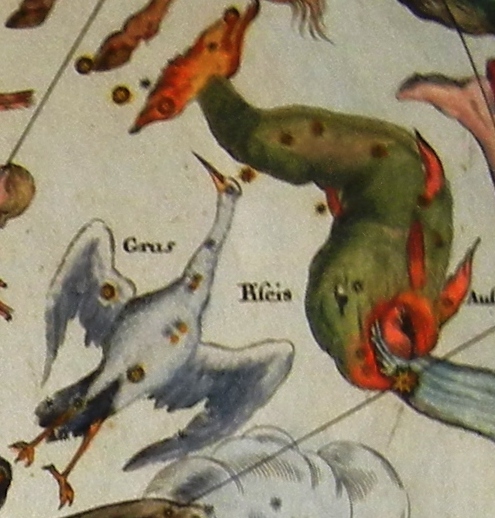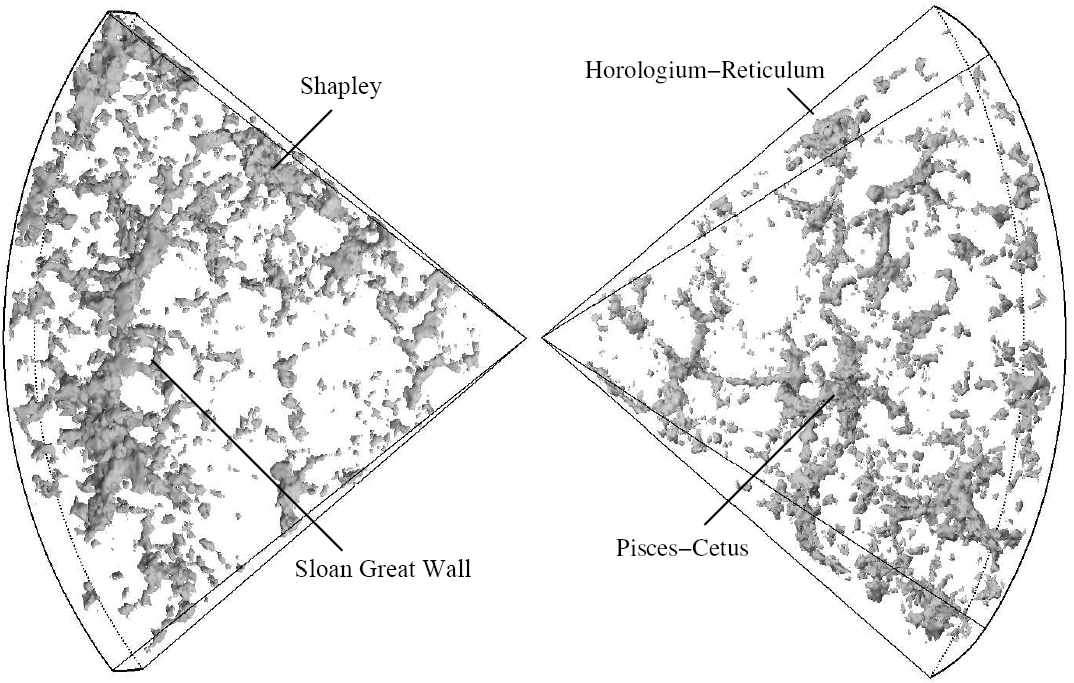|
Grus Wall
The Grus Wall is a superstructure of galaxies (" wall of galaxies") formed in the early universe, named for the Grus constellation in which it is found ("grus" is Latin for "crane"). It has an average redshift of z=2.38 and lies about 10.8 billion light-years away. The Wall is around 300 million light-years long, comparable in size to the Sloan Great Wall. The Wall is "perpendicular" to the Fornax Wall and Sculptor Wall The Sculptor Wall is a superstructure of galaxies ( "wall of galaxies") relatively near to the Milky Way Galaxy ( redshift of approximately z=0.03), also known as the Sculptor superclusters.Taotao Fang, David A. Buote, Philip J. Humphrey, Claude ....''Astrophysics and Space Science'', Volume 230, Issue 1-2, pp. 225-235 "Large-Scale Structures in the Distribution of Galaxies" ''08/1995'' The Grus Wall was discovered in 2003 by Povilas Palunas, Paul Francis, Harry Teplitz, Gerard Williger, and Bruce E. Woodgate through the use of wide-field telescopes. Referenc ... [...More Info...] [...Related Items...] OR: [Wikipedia] [Google] [Baidu] |
Galaxies
A galaxy is a system of stars, stellar remnants, interstellar gas, dust, dark matter, bound together by gravity. The word is derived from the Greek ' (), literally 'milky', a reference to the Milky Way galaxy that contains the Solar System. Galaxies, averaging an estimated 100 million stars, range in size from dwarfs with less than a hundred million stars, to the largest galaxies known – supergiants with one hundred trillion stars, each orbiting its galaxy's center of mass. Most of the mass in a typical galaxy is in the form of dark matter, with only a few percent of that mass visible in the form of stars and nebulae. Supermassive black holes are a common feature at the centres of galaxies. Galaxies are categorized according to their visual morphology as elliptical, spiral, or irregular. Many are thought to have supermassive black holes at their centers. The Milky Way's central black hole, known as Sagittarius A*, has a mass four million times greater than the Sun. As of ... [...More Info...] [...Related Items...] OR: [Wikipedia] [Google] [Baidu] |
Wall Of Galaxies
In cosmology, galaxy filaments (subtypes: supercluster complexes, galaxy walls, and galaxy sheets) Boris V. Komberg, Andrey V. Kravtsov, Vladimir N. Lukash; "The search and investigation of the Large Groups of Quasars" ; ;R.G. Clowes; "Large Quasar Groups - A Short Review"; ''The New Era of Wide Field Astronomy'', ASP Conference Series, vol. 232.; 2001; Astronomical Society of the Pacific; ; are the largest known structures in the universe, consisting of walls of gravitationally bound galaxy superclusters. These massive, thread-like formations can reach 80 megaparsecs ''h''−1 (or of the order of 160 to 260 million light-years) and form the boundaries between large voids. Formation In the standard model of the evolution of the universe, galactic filaments form along and follow web-like strings of dark matter—also referred to as the galactic web or cosmic web. It is thought that this dark matter dictates the structure of the Universe on the grandest of scales. Dark matte ... [...More Info...] [...Related Items...] OR: [Wikipedia] [Google] [Baidu] |
Grus (constellation)
Grus (, or colloquially ) is a constellation in the southern sky. Its name is Latin for the crane, a type of bird. It is one of twelve constellations conceived by Petrus Plancius from the observations of Pieter Dirkszoon Keyser and Frederick de Houtman. Grus first appeared on a celestial globe published in 1598 in Amsterdam by Plancius and Jodocus Hondius and was depicted in Johann Bayer's star atlas ''Uranometria'' of 1603. French explorer and astronomer Nicolas-Louis de Lacaille gave Bayer designations to its stars in 1756, some of which had been previously considered part of the neighbouring constellation Piscis Austrinus. The constellations Grus, Pavo, Phoenix and Tucana are collectively known as the "Southern Birds". The constellation's brightest star, Alpha Gruis, is also known as Alnair and appears as a 1.7-magnitude blue-white star. Beta Gruis is a red giant variable star with a minimum magnitude of 2.3 and a maximum magnitude of 2.0. Six star systems have been foun ... [...More Info...] [...Related Items...] OR: [Wikipedia] [Google] [Baidu] |
Latin
Latin (, or , ) is a classical language belonging to the Italic branch of the Indo-European languages. Latin was originally a dialect spoken in the lower Tiber area (then known as Latium) around present-day Rome, but through the power of the Roman Republic it became the dominant language in the Italian region and subsequently throughout the Roman Empire. Even after the fall of Western Rome, Latin remained the common language of international communication, science, scholarship and academia in Europe until well into the 18th century, when other regional vernaculars (including its own descendants, the Romance languages) supplanted it in common academic and political usage, and it eventually became a dead language in the modern linguistic definition. Latin is a highly inflected language, with three distinct genders (masculine, feminine, and neuter), six or seven noun cases (nominative, accusative, genitive, dative, ablative, and vocative), five declensions, four verb conjuga ... [...More Info...] [...Related Items...] OR: [Wikipedia] [Google] [Baidu] |
Redshift
In physics, a redshift is an increase in the wavelength, and corresponding decrease in the frequency and photon energy, of electromagnetic radiation (such as light). The opposite change, a decrease in wavelength and simultaneous increase in frequency and energy, is known as a negative redshift, or blueshift. The terms derive from the colours red and blue which form the extremes of the visible light spectrum. In astronomy and cosmology, the three main causes of electromagnetic redshift are # The radiation travels between objects which are moving apart (" relativistic" redshift, an example of the relativistic Doppler effect) #The radiation travels towards an object in a weaker gravitational potential, i.e. towards an object in less strongly curved (flatter) spacetime (gravitational redshift) #The radiation travels through expanding space (cosmological redshift). The observation that all sufficiently distant light sources show redshift corresponding to their distance from Earth ... [...More Info...] [...Related Items...] OR: [Wikipedia] [Google] [Baidu] |
Light-year
A light-year, alternatively spelled light year, is a large unit of length used to express astronomical distances and is equivalent to about 9.46 trillion kilometers (), or 5.88 trillion miles ().One trillion here is taken to be 1012 (one million million, or billion in long scale). As defined by the International Astronomical Union (IAU), a light-year is the distance that light travels in a vacuum in one Julian year (365.25 days). Because it includes the time-measurement word "year", the term ''light-year'' is sometimes misinterpreted as a unit of time. The ''light-year'' is most often used when expressing distances to stars and other distances on a galactic scale, especially in non-specialist contexts and popular science publications. The unit most commonly used in professional astronomy is the parsec (symbol: pc, about 3.26 light-years) which derives from astrometry; it is the distance at which one astronomical unit subtends an angle of one second of arc. Defini ... [...More Info...] [...Related Items...] OR: [Wikipedia] [Google] [Baidu] |
Sloan Great Wall
The Sloan Great Wall (SGW) is a cosmic structure formed by a giant wall of galaxies (a galaxy filament). Its discovery was announced from Princeton University on October 20, 2003, by J. Richard Gott III, Mario Jurić, and their colleagues, based on data from the Sloan Digital Sky Survey. Size The wall measures in length, located approximately one billion light-years away. In the sky, it is located within the region of the constellations Corvus, Hydra and Centaurus. It is approximately 1/60 of the diameter of the observable universe, making it the sixth largest known object after the large quasar groups Clowes-Campusano LQG, U1.11, Huge-LQG, the Giant GRB Ring and the galaxy filament Hercules–Corona Borealis Great Wall (Her-CrB GW), respectively. The Sloan Great Wall is between 1.8–2.7 times longer than the CfA2 Great Wall of galaxies (discovered by Margaret Geller and John Huchra of Harvard in 1989). It also contains several galactic supercluster A superclus ... [...More Info...] [...Related Items...] OR: [Wikipedia] [Google] [Baidu] |
Fornax Wall
The Fornax Wall is a superstructure known as a galaxy filament or galaxy wall. It is a long filament of galaxies with a major axis longer than its minor one. The filament contains not only Dorado Group but also the Fornax cluster The Fornax Cluster is a cluster of galaxies lying at a distance of 19 megaparsecs (62 million light-years). It has an estimated mass of solar masses, making it the second richest galaxy cluster within 100 million light-years, after the consider ... of galaxies, which lies at the same distance. It is "parallel" to the Sculptor Wall and "perpendicular" to the Grus Wall. References {{galaxy-stub Galaxy filaments Southern Supercluster ... [...More Info...] [...Related Items...] OR: [Wikipedia] [Google] [Baidu] |
Sculptor Wall
The Sculptor Wall is a superstructure of galaxies ( "wall of galaxies") relatively near to the Milky Way Galaxy ( redshift of approximately z=0.03), also known as the Sculptor superclusters.Taotao Fang, David A. Buote, Philip J. Humphrey, Claude R. Canizares, Luca Zappacosta, Roberto Maiolino, Gianpiero Tagliaferri and Fabio Gastaldello; ''CONFIRMATION OF X-RAY ABSORPTION BY WARM-HOT INTERGALACTIC MEDIUM IN THE SCULPTOR WALL''; 2010 ApJ 714 1715, , , /ref>Fairall, A. P., Palumbo, G. G. C., Vettolani, G., Kauffman, G., Jones, A., & Baiesi-Pillastrini, G., ''Largescale Structure in the Universe - Plots from the Updated Catalogue of Radial Velocities of Galaxies and the Southern Redshift Catalogue'' Journal: R.A.S. MONTHLY NOTICES V.247, NO.2/NOV15, P. 23P, 1990. Bibliographic Code:(slices 8 and 10 under SGH) The superstructure is also called the Southern Great Wall, the Great Southern Wall, or just the Southern Wall, in reference to the CfA2 Great Wall, Northern Great Wall. The st ... [...More Info...] [...Related Items...] OR: [Wikipedia] [Google] [Baidu] |
Cambridge University Press
Cambridge University Press is the university press of the University of Cambridge. Granted letters patent by Henry VIII of England, King Henry VIII in 1534, it is the oldest university press A university press is an academic publishing house specializing in monographs and scholarly journals. Most are nonprofit organizations and an integral component of a large research university. They publish work that has been reviewed by schola ... in the world. It is also the King's Printer. Cambridge University Press is a department of the University of Cambridge and is both an academic and educational publisher. It became part of Cambridge University Press & Assessment, following a merger with Cambridge Assessment in 2021. With a global sales presence, publishing hubs, and offices in more than 40 Country, countries, it publishes over 50,000 titles by authors from over 100 countries. Its publishing includes more than 380 academic journals, monographs, reference works, school and uni ... [...More Info...] [...Related Items...] OR: [Wikipedia] [Google] [Baidu] |
Bruce Woodgate
Bruce E. Woodgate (1939 – April 28, 2014) was a British-born American aerospace engineer, inventor and astronomer, who worked at NASA's Goddard Space Flight Center for forty years. He was the principal investigator of the Space Telescope Imaging Spectrograph (STIS), a spectrograph and camera which was installed on the Hubble Space Telescope in 1997. Woodgate oversaw the design, development and construction of the STIS. Astronomers and other scientists have used the STIS to study and measure a wide range of light wavelengths in deep space. Woodgate's invention has been called a "game changer" in the field of astronomy, allowing scientists to discover an "invisible high-speed collision" near SN 1987A, as well as new planets and black holes. A power failure knocked STIS offline in 2004, but it was repaired in 2009. Aside his from his work as the principal investigator on STIS, Woodgate had also begun development on a new UV detector which counts protons utilizing new nano-f ... [...More Info...] [...Related Items...] OR: [Wikipedia] [Google] [Baidu] |







